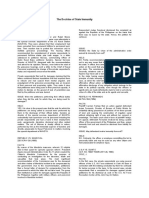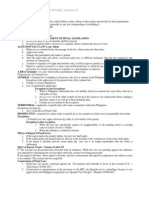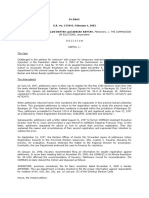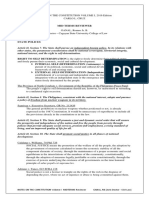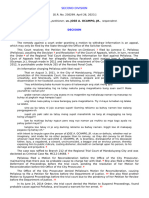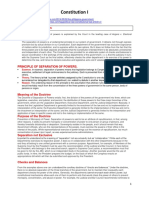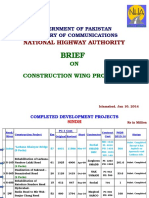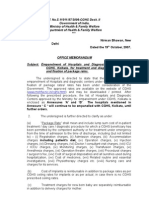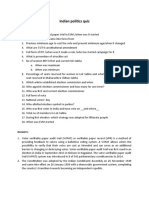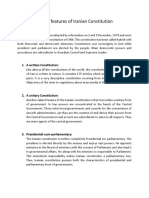Chapter 1. Statutes: A. in General
Uploaded by
Marco RamonChapter 1. Statutes: A. in General
Uploaded by
Marco RamonCHAPTER 1.
STATUTES
A. IN GENERAL
1.1 Laws, generally
1. Law refers to the whole body or system of law.
2. Jural and concrete sense. Law means a rule of conduct formulated and made obligatory by legitimate
power of the state. I
1.2 Statutes, generally
1. A statute is an act of the legislature as an organized body, expressed in the form, and passed according to
the procedure, required to constitute it as part of the law of the land
2. Statutes may either be
a. Public – affects the public at large or the whole community
i. General – applies to the whole state; operates upon all the people or all of a class
ii. Special – relates to particular persons or things of a class; particular community
iii. Local – confined to a specific place or locality (e.g., municipal law)
1.3 Permanent. In terms of duration, a statute may be permanent
1. Permanent – not limited in duration, but continues until repealed
2. Temporary – duration is for a limited period of time; designed to meet an emergency
1.4 Other classes
1. Application: Prospective, Retroactive
2. Operation: Declaratory, Curative, Mandatory, Directory, Substantive, Remedial, and Penal
3. Forms: Affirmative, Negative
1.5 Manner of referring to statutes
1. 1901-1935 – Philippine Commission and the Philippine Legislature issued PUBLIC ACTS
2. 1936-1946 – During the Commonwealth, COMMONWEALTH ACTS were passed
3. 1946-1972; 1987-onwards – REPUBLIC ACTS were passed by Congress of the Philippines passed, and
under the 1987 Constitution, respectively
4. Batas Pambansa
5. Presidential Decrees
B. ENACTMENT OF STATUTES
1.6 Generally
1. Parts of legislative history: (1) steps and actions taken, and (2) words and language employed to enact a
statute – AIDS IN ASCERTAINING LEGISLATIVE INTENT.
1.7 Legislative power of Congress
ARTICLE VI
The Legislative Department
SECTION 1. The legislative power shall be vested in the Congress of the Philippines which shall consist
of a Senate and a House of Representatives, except to the extent reserved to the people by the provision
on initiative and referendum.
1. LEGISLATIVE INTENT POWER – is the power to make, alter and repeal laws.
1
2. Compared with Executive and Judicial powers, the Legislative power appears to be more extensive. For
without law, the executive has nothing to execute, and the judiciary has nothing to interpret and apply. The
grant of legislative power means a grant of all legislative power.
1.8 Procedural
1. Detailed procedure is embodied in the Rules of both Houses of Congress
2. A law may not be declared unconstitutional when has been violated in its passage are merely internal rules
of procedure of the House.
1.9 Steps. Procedure of How a Bill Becomes a Law
1. Bill vs. Statute. Among the most important things studied in Article VI, The Legislative Department, is the
procedure of how a bill becomes a law. A bill is a proposed law. As such, it is not yet binding nor does it
confer or affect the rights and duties of individuals. It becomes a law only after it has gone through all the
formalities and solemnities of the legislation process as prescribed in the Constitution. The law enacted by
the Congress is called a statute.
2. The procedure is as follows:
a. A bill is introduced by any Member of the Senate or the House of Representatives by filing it with
the Office of the Secretary where it is calendared for the First Reading. Some bills, however must
originate exclusively from the House of Representatives, such as the appropriation, revenue or
tariff bills, bills authorizing increase of the public debt, bills of local application, and private bills,
although the Senate may propose or concur with amendments.
b. During the first reading the number, title, and name/s of author/s are read. The subject of the
bill as expressed in its title must only be one in order to avoid hodge-podge or log-rolling legislation
which entails insertion of many unrelated subjects. The bill is referred to an appropriate committee
for study. Public hearings or consultations may be conducted by the committee before it
recommends the bill for approval, with or without amendments, or for consolidation with similar
bills, or for disapproval. If it is disapproved, the bill is said to be “killed.” If approved or reported out,
it will calendared for the second reading.
c. During the second reading, which is the start of the most important stage, the bill is read in its
entirety, together with the amendments introduced by the committee, if there are any. The bill will
thereafter be debated upon and amended if the members deem it necessary. The approved bill in
the second reading is printed in its final form and copies of it are furnished to the members three
days before the third reading.
d. During the third reading, only the title of the bill is read, and immediately after, the Members will
vote thereon and their votes (yeas and nays) will be entered in the journal. No further amendments
are allowed.
e. The approved bill is referred to the other house where it also undergoes three readings on three
separate days. If compromise or reconciliation of conflicting provisions is necessary because of the
differences in the House Bill and Senate Bill version, the bill shall be submitted to a joint bicameral
Conference Committee.
CONFERENCE COMMITTEE – may deal directly with the subject matter or it may be limited to
resolving the precise differences between the two houses.
f. After the bill has been approved on third reading on both Houses it shall be submitted to the
President for his action. He approves by signing the bill; he disapproves by vetoing and returning
the bill with his objections to the House of origin. In order to override the veto of the President, two-
thirds of all the Members of each house voting separately must agree to pass the bill. If the
President will not act on the bill in thirty days, the bill shall become a law as if signed by him.
2
“Pocket veto” is not allowed under the laws.
g. The enrolled bill or bill as printed and approved by the Congress and the President shall be
published in a newspaper of general circulation or in the Official Gazette of the Government and
shall become binding fifteen days following its publication unless another date is provided therein.
h. Three Readings on Three Separate Days. What is important to remember in all these steps is the
rule of “three readings on three separate days.” Except when the President certifies to the
necessity of its immediate enactment to meet a public calamity or emergency, no bill can become a
law unless it passes three readings on three separate days in both Houses of the Congress.
ARTICLE VI
The Legislative Department
(2) No bill passed by either House shall become a law unless it has passed three readings on separate
days, and printed copies thereof in its final form have been distributed to its Members three days before
its passage, except when the President certifies to the necessity of its immediate enactment to meet a
public calamity or emergency. Upon the last reading of a bill, no amendment thereto shall be allowed, and
the vote thereon shall be taken immediately thereafter, and the yeas and nays entered in the Journal.
C. PARTS OF STATUTES
1.10 Statutes generally contain the following parts
1. Preamble. A prefatory statement or explanation or a finding of facts, reciting the purpose, reason
or occasion for making the law to which the it is prefixed. Found after enacting clause and before
the body of the law. [vis explanatory note] [e.g., PDS, EOs]
2. Title of Statute.
SECTION 26. (1) Every bill passed by the Congress shall embrace only one subject which shall be
expressed in the title thereof.
a. Purposes of title requirement. Aims to apprise the legislators of the object, nature and
scope of the provisions of the bill, and to prevent the enactment into law of matters which
have not received the notice, action and study of the legislators. In particular
i. Prevent hodgepodge or log-rolling legislation
ii. Prevent surprise or fraud upon the legislature,
iii. Fairly apprise the people
iv. Used as a guide to ascertain legislative intent
b. Subject of repeal of statute
c. How requirement of title construed
i. Should be liberally construed
ii. In case of doubt, resolve against the doubt and in favor of constitutionality of the
statute
d. When requirement not applicable
e. Effect of insufficiency of title. Noncompliance shall render the law null and void. Does not
apply to municipality or city ordinances
3
3. Enacting clause. Written after the title; which states the authority by which the act is enacted.
4. Purview or body of statute. Tells what the law is all about. Divides the act into SECTIONS, each
of which is NUMBERED, and contains SINGLE PROPOSITION.
a. A short title
b. A policy section
c. Definition section
d. Administrative section
e. Sections prescribing standards of conduct
f. Section imposing sanctions for violation of its provisions
g. Transitory provision
h. Separability clause
i. Repealing clause
j. Effectivity clause
5. Separability clause. States if any provision of the act is declared invalid, the remainder shall not
be affected thereby. The presumption is that the legislature intended a statute to be effective as a
whole.
6. Repealing clause.
7. Effectivity clause
1.11 Meaning of certain bills originating from lower House
1. The procedure for the enactment of ordinary bills applies to the enactment of appropriations
and
revenue measures. However, they can only originate from the lower House, but the Senate may propose
or concur with amendments. As elected from the districts, the members of the House can be expected to be
more sensitive to the local needs and problems. The Senate is expected to approach the problem from the
national perspective.
1.12 Enactment of budget and appropriations law
A general appropriation bill. Is a special type of legislation, whose content is limited to specified
sums of money dedicated to specific purposes or a separate fiscal unit. Inherent power of
appropriation is the power to specify how the money shall be spent.
1. Budget preparation
2. Budget authorization
3. Budget execution
4. Budget accountability
1.13 Restrictions in passage of budget or revenue bills.
1.14 Rules and records of legislative proceedings
1. Journal of its proceedings
1.15 Power to issue its rules of proceedings
1.16 Unimpeachability of legislative journals
4
1. Journal excludes parts that may affect National Security, and the yeas and nays on any question
may be entered at the request of the 1/5 of the members present.
2. It is regarded conclusive with respect to matters that are required by the Constitution to be
recorded therein.
3. In case of conflict between the enrolled bill and the legislative journals, it is the former that should
prevail, except as to matters that the Constitution requires to be entered in the journals, eg. The
yeas and nays on the final reading of a bill or any question at the request of at least 1/5 of the
members, the objections of the President to a vetoed bill, and the names of voting for or agains
overriding his veto.
https://tamayaosbc.wordpress.com/2014/08/02/the-philippine-government/
1.17 Enrolled Bill. (i) Passed by Congress, (ii) authenticated by the Speaker and Senate President
and (iii) approved by the President.
Enrolled Bill Doctrine. The (1) signing of a bill by the Speaker of the House and (2) the
Senate President and (3) the certification of the Secretaries of both Houses of Congress that it
was passed are conclusive of its due enactment.
Due to ‘RESPECT DUE TO EQUAL AND INDEPENDENT DEPARTMENT,’ the court cannot go
behind the enrolled act to discover what really happened. This respect demands that courts act
upon the faith and credit of what the officers of the said branches attests to as the official acts of
their respective department.
If there is mistake, the remedy is by amendment by enacting a curative legislation, not by judicial
decree.
1.18 Withdrawal of authenticity, effect of
If there is substantial discrepancy between the text of the bill as shown in the journal of
proceedings, and the enrolled bill, the court can declare that the bill has not been duly enacted.
1.19 Summary Rules.
Internal rules vs constitutional requirements: noncompliance to the former will not invalidate the
law. [Arroyo vs de Venecia]
D. ISSUANCES, RULES AND ORDINANCES
1.20 Presidential issuances
Issued in the exercise of ORDINANCE POWER of the President
Related Case Laws
o David vs Arroyo. Under Administrative Code of 1987 (Chapter 2, Book 3 of EO 292),
ordinance power of the President includes issuance of the ff
1. Executive Orders – promulgates acts providing rules to implement constitutional
or statutory powers
2. Administrative Orders – promulgates acts in relation to his duties as
administrative head of governmental operations
5
3. Proclamations – promulgates acts fixing a date or declaring a status or condition
of public interest in relation to specific law or regulation
4. Memorandum Orders – acts in relation to specific office of the government
5. Memorandum Circulars – acts in relation to internal administration for information
or compliance of government offices
6. General of Special Orders – acts in relation to the President capacity as
Commander in chief of the AFP
GMA and Marcos ordinance power – NOT THE SAME; GMA cannot issue Presidential
decrees as these are issue in the exercise of the President’s legislative power in the period of
Martial Law.
o Ople vs Torres – defines the scope of the ordinance power of the President seeking to
declare unconstitutional AO 308 (Adoption of a National Computerized Identification
Reference System) on 2 ground: (i) usurpation of the power of Congress to legislate; and (ii)
intrusion on citizenry’s protected zone of privacy.
AO 308 is not a mere administrative order by a law, and hence BEYOND THE POWER of
the President to issue; it involves a subject that is not appropriate to be covered by an
AO. The establishment for the first time of a NCIRS requires a delicate adjustment of
contending state policies.
Impairs citizens capacity to exercise their rights and privileges
Violates the right to privacy.
1.21 Administrative rules and regulations. While the legislature can delegate legislative power to
a public administrative agency through its rule making authority, the law should
1. be complete in itself; and
2. fix a standard [maps out boundaries and specifies which agency to apply it.
Related case laws
o [Cemco Holdings vs National Life Insurance.] The rulemaking power cannot be
extended to amend or expand the statutory requirements or to embrace matters not
covered by the statute.
o The law on the Home Devt Mutual Fund or PagIBIG Fund provides that waiver or
suspension of coverage may be granted in favor of an employer who have their own
“provident/retirement AND/OR employee housing plans.” The Board of the HDMF
issued rules deleting the word OR. Such was a radical imposition of a more stringent
condition for waiver. In doing so, the board exceeded its rule making power.
o COMELEC issuance to implement
1.22 Illustrative cases on validity of executive orders, rules and regulations. [Executive
Secretary vs Southwing Heavy Industries, Inc.] Requisites for a valid EOs or any administrative
rule
1. Its promulgation must be authorized by the legislature (statutory basis);
2. It must be promulgated in accordance with the prescribed procedure (requires notice and
hearing);
3. It must be within the scope of the authority given by the legislature; and
4. It must be reasonable. Sample cases – Lupangco vs Court of Appeal (PRC resolution
prohibiting examinees from attending review classes and receiving handout materials,
tips and the like three days before the date of examination)
Ratione cessat lex, et cessat lex – when the reason for the law
ceases, the law ceases.
6
1.23 Administrative rule and interpretation distinguished. Administrative rule or regulation
(binding in court) vs. administrative interpretation of a law (not binding in court)
1.24 Supreme court rulemaking power. 1997 Rules of Procedures
SC does not have the power to promulgate rules which are substantive in nature, only
procedural, e.g.,
1. protection and enforcement of constitutional rights,
2. pleading, practice, and procedure in all courts,
3. admission to the practice of law, the Integrated Bar, and
4. legal assistance to the underprivileged.
If rules take away vested right, it is not procedural. If it creates rights such as the right to
appeal, it is substantive.
1.25 Legislative power of local government units. Ordinances to be valid must:
1. Not contravene the Constitution or any statute
2. Not be unfair or oppressive
3. Not be partial or discriminatory
4. Not prohibit but may regulate trade
5. Be general and consistent with public policy
6. Not be reasonable
1.26 Barangay ordinance. After approval of a majority vote, it will be
1. subject to review by sangguniang bayan or panlungsod to check its consistency with law
or municipal or city ordinance;
2. to be acted upon within 30 days, otherwise, it is deemed approved;
3. if deemed inconsistent, it will be returned for adjustment, amendment or modification.
1.27 Municipal ordinance. After approval of a majority vote (being a quorum) of the sangguniang
bayan, it will be
1. submitted to the municipal Mayor, who will act on it within 10 days, otherwise, deemed
approved; the SB may override the veto of the Mayor by two thirds vote of all SB
members
2. subject to review by sangguniang panlalawigan; and
3. to be acted upon within 30 days, otherwise, it is deemed approved.
1.28 City Ordinance. After approval of a majority vote (being a quorum) of the sangguniang
panlungsod, it will be
1. submitted to the city Mayor, who will act on it within 10 days, otherwise, deemed
approved; the SB may override the veto of the Mayor by two thirds vote of all SB
members
2. subject to review by sangguniang panlalawigan, if a component city (NOT highly
urbanized); and
3. to be acted upon within 30 days, otherwise, it is deemed approved.
1.29 Provincial ordinance. After approval of a majority vote (being a quorum) of the sangguniang
panlalalawigan, it will be
1. submitted to the Governor, who will act on it within 15 days, otherwise, deemed
approved; the SB may override the veto of the Governor by two thirds vote of all SB
members.
E. VALIDITY OF STATUTE
7
1.30 Presumption of constitutionality
Responsibility of upholding the Constitution rests not only on the courts but on the legislature and
executive as well.
The final authority to declare a law unconstitutional is the Supreme Court en banc
Lower courts also has jurisdiction to rule on unconstitutionality of a law. [Drilon vs Lim]
1.31 Requisites for exercise of judicial power.
1.32 Appropriate case
A controversy is a justiciable case if it refers to a matter which is appropriate for court review.
Political questions. A class of case that the court hesitates to rule on; being a function of
the separation of powers, the court will not interfere unless there is a clear need to uphold the law
and the constitution. [QUESTION OF WISDOM, JUSTICE OR EXPEDIENCY OF LEGISLATION]
Judicial power includes (i) to settle actual controversies involving rights which are legally
demandable, and (ii) to determine if there has been a grave abuse of discretion amounting to
lack or excess of jurisdiction.
1.33 Standing to sue
Legal Standing or Locus standi. (i) personal and substantial interest in the case; (ii)
the party has sustained or will sustain direct injury as a result of the act being challenged.
A citizen acquires standing if he can establish that (i) has suffered actual or threatened injury; (ii)
the injury is traceable to the challenged action; and (iii) the injury is likely to be redressed by a
favorable action.
Kinds of standing:
o Citizen – sustained or is in imminent danger of sustaining some direct injury as a result of
the enforcement of challenged act; when proceeding involves the assertion of PUBLIC
RIGHT
o Taxpayer - acquires standing if act involves misapplication of public funds
o Legislators – has legal standing to question the validity of a presidential veto, if action
was made without or in excess of the authority of the President intrusion of the
executive into the domain of the legislature. This impairs the power of the Congress, and
as such the power of each member
o Association –
o Class suits
JUDICIAL DISCRETION. When controversies are of paramount importance, transcendental
importance, the Court may aside requirement for legal standing [IBP vs Zamora].
1.34 When to raise constitutionality. AT THE EARLIEST POSSIBLE OPPORTUNITY. (i) in the
complaint or petition by plaintiff or petitioner; (ii) answer by defendant or respondent. If not
raised at the pleading, it cannot be raised in the trial, if not raised in the trial, it cannot be
considered on trial.
Exemptions:
1. motion for reconsideration or new trial, when the statute was not in existence during the
previous trial;
2. can be raised at any stage of the proceedings in criminal cases;
3. in civil cases, where the determination is necessary to the decision of the lower court.
1.35 Necessity of deciding constitutionality
1. Court will not accept if issue can be tackled on some other grounds
8
2. Court will dismiss the case when issue becomes moot.
3. Court will accept issue of paramount public interest, even if
issue has become moot, and there is undeniable necessity for a
ruling
1.36 Summary of Essential Requisites for Judicial Review. [Francisco, Jr vs House of
Representatives]
An actual case or controversy
o Justiciability
Person challenging the act must have standing to challenge
o REAL PROPERTY IN INTEREST (concept of civil procedure/HAS capacity to sue; ) vs.
STANDING (has constitutional underpinnings; some case suits are brought not by parties
who have been personally injured by the operation of a law or by official action taken byt
by CONCERNED CITIZENS [involves the assertion of public right], TAXPAYERS, OR
VOTERS WHO ACTUALLY SUE IN THE PUBLIC INTEREST.):
The question of constitutionality must be raised at the earliest possible opportunity.
o RIPENESS. Something had been accomplished or performed by either branch
o PREMATURITY
[Tan vs Macapagal].
[AVOIDS POLITICAL QUESTIONS; PRESUMPTION OF CONSTITUTIONALITY]
Political question – as what it connotes, a question of policy; questions
that, under the Constitution, are to be decided by the people in their
sovereign capacity, or in regard to which full discretionary authority has
been delegated Legislature or executive branch of the government. It is
concerned with issues dependent upon the wisdom, not legality, of a
particular measure. [Tanada vs Cuenco]
JUSTICIABLE POLITICAL QUESTIONS
1. A textually demonstrable constitutional commitment of the issue to coordinate political
department
2. The lack of judicially discoverable and manageable standards for resolving it
3. The impossibility of deciding without an initial policy determination of a kind clearly for
non-judicial discretion
The issue of constitutionality must be the very LIS MOTA of the case or crux of the
controversy [the resolution of the question is unavoidably necessary to the decision of the case
itself.]
1.37 Test of Constitutionality
A statute may be unconstitutional
1. Because It is not within the legislative power to enact, or It creates or establishes methods or
forms that infringe constitutional principles, or Its purpose or effect violates the Constitution or its
basic principles
2. When it allows something to be done which the fundamental law condemns or prohibits or when it
attempts to validate a course of conduct the effect of which the Constitution specifically forbids
3. Because it is vague; lacks comprehensible standards that men of common intelligence must
necessarily guess. In such instance, the statute is repugnant to the Constitution in two respects:
9
i. it violates due process for failure to accord the people fair notice of what conduct to avoid;
and
ii. it leaves law enforces unbridled discretion in carrying out its provisions
ORDINANCES, the test of validity are
it must not contravene the Constitution or any statute
it must not be unfair or oppressive
it must not be partial or discriminatory
it must not prohibit but may regulate trade
it must be general and consistent with public policy
it must not be unreasonable
1.38 Effects of Unconstitutionality
The general rule is that an unconstitutional act
is not a law
it confers no rights
it imposes no duties
it affords no protection
it creates no office
it is inoperative as though it has never been passed
TWO VIEWS on effects of a Declaration of the Unconstitutionality of a statute
1. Orthodox – see above; Article 7, 2nd para, Civil Code
2. Modern – les stringent than above; does not annul or repeal the statute; just simply refuses to
recognize it and determines the rights of the parties just as if such statute had no existence.
1.39 Invalidity due to change of conditions.
Above 1.38 does not apply when a statute is declared invalid because of the change of
circumstances affecting its validity. This belongs to the class of EMERGENCY LAWS.
1.40 Partial Invalidity.
The valid portion, if separable from the invalid, may stand and be enforced.
The presence of Separability Clause creates the presumption that the legislature
intended separability, rather than complete nullity of the statute. EXEMPTIONS: when parts of a
statute are so mutually dependent and connected
F. EFFECT AND OPERATION
1.41 When laws take effect.
Official Gazette OR in a newspaper of general circulation
Before the public is bound by the provision of the law, they must be published and the people
officially and especially informed thereof
1.42 When Presidential issuances, rules and regulations take effect.
Two types of rules and regulations:
1. Those whose purpose is to enforce or implement existing laws – requires PUBLICATION
10
2. Those which are merely interpretative or merely internal not concerning the public – DOES NOT
REQUIRE PUBLICATION
1987 Administrative Code also requires, in addition to publication, filing of 3 copies with Philippine
Law Center where interested persons can readily secure copies or check on their existence.
1.43 When local ordinance take effect.
Ten days from the date a copy of thereof is posted in a bulletin board at the entrance, in at least
two conspicuous places
The secretary to the Sanggunian shall undertake above not later 5 days after approval.
Ordinance shall be disseminated in Filipino or English. The Secretary shall record the approval
and posting
The gist of ordinance with penal sanctions shall be published in a newspaper of general
circulation within the province; if there is none, posting shall be made in all municipalities and
cities of the province.
HUC and CC ordinances shall be posted in a local newspaper, if there is none, in the newspapers
of general circulation. An HUC has a minimum population of 200,000 as certified by NSO with
annual income amounting to P50 million as certified by the city treasurer.
1.44 Statutes continue in force until repealed.
Permanent and Indefinite. Characterized most statutes. It continues in force until changed or
repealed by the legislature.
Temporary. Enforced for a limited period, and they terminate upon the expiration. Does nor
require repealing statute
1.45 Territorial and personal effect of statutes.
Permanent and Indefinite. Characterized most statutes. It continues in force until changed or
repealed by the legislature.
1.46 Manner of computing time.
Ten calendar days, not working days.
.Exclude-first and include-the-last day rule -does not apply to the computation of the period of
prescription of a crime.
11
CHAPTER 2.
CONSTRUCTION AND INTERPRETATION
A. NATURE AND PURPOSE
2.1 Construction defined.
Construction is the art or process of (1) discovering and (2) expounding the (1) meaning and (2)
intention of the authors of the law, where that intention is rendered doubtful by reason (1) of the
ambiguity in its language or (2) of the fact that the given case is not explicitly provided for in the law.
2.2 Construction and interpretation distinguished.
Synonymous
2.3 Rules of construction, generally.
(1) are tools used to ascertain legislative intention; (2) are not rules of law, but mere axioms of
experience; (3) there is presumption that legislature knows the rules of statutory construction ; (4) in
case of doubt, law will be construed in accordance with the settled principles of interpretation.
Sample rules of statutory construction adopted in legislature: (1) Article 10 of the Civil Code… In
case of doubt, … intended right and justice to prevail… (2) Section 4 of the Labor Code… All
doubts… shall be resolved in favor of labor…; (3) Section 5 of the LGC of 1991…liberally
interpreted… in case of doubt… shall be resolved in favor of devolution of powers and of the LGU…
Legislature also defined the words and phrases therein.
RULES OF STATUTORY CONSTRUCTION HAVE NO BINDING EFFECT ON THE COURTS, except
if they are embodied as part of a statute.
2.4 Purpose or object of construction.
The object of judicial interpretation of a statute is to determine legislative intent, either expressly or
impliedly, by the language used… to ascertain the meaning and will of the lawmaking body… to
discover the true intention of the law…
2.5 Legislative intent, 2.6 Legislative purpose. 2.7 Legislative meaning.
generally.
INTENT is… (1) the (1) Is the reason why a (1) Is what the law means;
particular statute was (2) what it comprehends;
Essence of the law… (2) enacted by the legislature; (3) what it covers or
the law… (3) the Key to, (2) What it intends to embraces; (4) what its limits
and the Controlling factor achieve or accomplish; (3) or confines are; (5) what
in, its construction or what is its object. does the legislature really
interpretation… (4) the A legislation is an active
intend; (6) what is in its
instrument of government
Spirit which gives life to which, for purposes of
mind.
legislative enactment…(5) interpretation, means that Synonymous with legislative
either purpose or meaning, laws have ends to be intent
but the ascertainment of achieved.
legislative intent depends
12
more on a determination of
the purpose and object of
the law.
Synonymous with legislative
meaning
2.8 Graphical Illustration.
…
2.9 Matters inquired into in construing a statute.
More than determining the legislative intention or meaning, it is also important that the intention or
meaning is expressed in a way that it gives the law legal effect and validity, that is, the
language used sufficiently expresses that meaning = [object of inquiry]
The legal act consists of two elements; (1) internal (intention); and (2) external (expression).
2.10 Where legislative intent is ascertained.
STATUTE – the primary source of legislative intent.
If legislative intent is ambiguous from the statute, the court will refer to (1) legislative history (what
was in the legislative mind at the time statute was enacted, circumstances at the time it was enacted,
what evil was meant to be redressed); (2) purpose (the reason or cause behind the law, mischief to
be suppressed, and the policy which dictated its passage); (3) effect of the law.
B. POWER TO CONSTRUE
2.11 Construction is a judicial function.
COURT – has the final word on what the law means.
The Supreme Court construes law in controversies which are ripe for judicial resolution. It dismisses
the case when it has become moot and academic, which means that: (1) purpose has become stale;
(2) no practice relief can be granted; (3) relief has no practical effect. EXCEPTIONS: (1) if it is
capable of repetition, yet evading review; (2) public interest requires its resolution; (3) rendering a
decision on the merits would be of practical value.
The courts (1) interpret the laws always in the context of factual situation of each case; (2) do not
give legal opinion on hypothetical cases or those which have become moot.
The circumstances of time, place, event, person and particularly attendant circumstances and actions
[T, P, E, P, PACA] before, during and after the operative fact should be all taken in their totality so that
justice can be rationally and fairly dispensed.
2.12 Legislature cannot overrule judicial construction.
Resolution or declaratory act – how the legislature may indicate its construction of a statute.
If legislature may declare what a law means, it will cause confusion… violation of the fundamental
principle of the constitution of separation of powers. Endencia vs David; Perfection vs Meer on salary
of judicial officers being tax exempt.
13
2.13 When judicial interpretation may be set aside.
The Supreme Court itself, may change or overrule its previous construction as interpretation of a
statute or a constitutional provision is never beyond modification or nullification.
The rule that SC has the final word in the interpretation or construction of a statute merely means that
the legislature, by law or resolution, cannot, modify or nullify judicial construction without modifying or
repealing the very statute that is the subject of construction.
2.14 When court may construe statute.
Construction is the means by which the court clarifies to arrive at the true intent of the law.
2.15 Condition sine qua non (prerequisite) before courts can construe statues, ambiguity defined.
The court may construe a statute under the condition that there is doubt or ambiguity.
Ambiguity is when a condition has 2 or more meanings, is understood in more than one way, or is
referred to two or more things at the same time, or it is susceptible of more than one interpretation.
There is ambiguity when statute is capable of being understood by reasonably well-informed persons
in either of two senses.
2.16 Court may not construe where statute is clear.
A statute that is CLEAR and FREE FROM DOUBT does not require the court to construe.
Application of the law is the first and fundamental DUTY OF THE COURT.
Construction or interpretation is the VERY LAST FUNCTION which the court should exercise.
Where the law speaks in clear and categorical language, there is NO ROOM for
INTERPRETATION, only ROOM for APPLICATION.
A meaning that does not appear nor is intended or reflected in the very language of the statute cannot
be placed therein by construction. Courts may not, in the guise of interpretation, enlarge the
scope of a statute and include therein situations not provided or intended by the lawmakers. An
omission at the time of enactment, whether careless or calculated, cannot be judicially
supplied however later wisdom may recommend the inclusion. [see section 2.22]
Where the words and phrases of a statute are not obscure and ambiguous, the meaning and intention
of the legislature should be determined from the language employed, and where there is no ambiguity
in the words, there should be no room for construction.
2.17 Verba legis or plain meaning rule.
xxx.
2.18 Rulings of Supreme Court part of legal system.
Article 8 of Civil Code.
Legis interpretato legis vim obtinet – the construction of law obtains the force of law.
Stare decisis et non quieta novere – to stand by decisions and not to disturb settled matters.
This assures certainty and stability in the legal systems.
2.19 Judicial rulings have no retroactive effect.
Article 4 of Civil Code.
14
Lex prospicit, non respicit – the law looks forward not backward. This is based on the principle
that retroactive application of a law usually divests rights that have already become vested or impairs
the obligations of contracts, and hence, is unconstitutional.
2.20 Only Supreme Court en banc can modify or abandon principle of law, not any division of the
Court.
To modify or reverse previous decisions, requires the court sitting en banc.
.
2.21 Court may issue guidelines in construing statute.
In construing a statute, the enforcement of which may tread on sensitive areas of constitutional rights,
the court may issue guidelines in applying the statute, not to enlarge or restrict it but to clearly
delineate what the law requires.
C. LIMITATIONS ON POWER TO CONSTRUE
2.22 Courts may not enlarge nor restrict statutes.
Common sense and good faith are the leading stars that should guide judicial construction.
[see section 2.16]
Courts should not construe statutes are “perfectly vague”, when it lacks comprehensible standards
that men of common intelligence must necessarily guess at its meaning and differ as its application,
and it violates due process for failure to accord persons fair notice of the conduct to avoid and leave
law enforcers unbridled discretion in carrying out its provisions.
Utterly vague on its face – cannot be clarified by either a saving clause or by construction.
.
2.23 Courts cannot be influenced by questions of wisdom.
Courts do not pass upon questions of wisdom, justice or expediency of legislation for it is not within
their province to supervise legislation and keep it within the bounds of propriety and common sense.
Courts do not sit to resolve the merit of conflicting theories for debatable questions are for legislature
to decide.
2.24 Courts cannot be influenced by questions of wisdom.
15
CHAPTER 3. AIDS TO CONSTRUCTION
A. IN GENERAL
3.1 Generally.
Intrinsic aids – found in the printed page of the statute [12 intrinsic aids) T P C P C H L I P D C P
Extrinsic aids – extraneous facts and circumstances
3.2 Title. (1)
May indicate the legislative intent to extend or restrict the scope of the law
3.3 When resort to title is not authorized
3.4 Preamble (2)
May restrict what otherwise appears to be a broad scope of a law
3.5 Illustration of rule
3.6 Context of whole text
As the best source to ascertain the legislative intent, the statute must be taken as a whole – the words,
phrases, sentences, sections, clauses, provisions, and their relation to another.
3.7 Punctuation marks (3)
Semi-colon indicates a separation in the relation of the thought (a degree greater than that expressed by a
comma); succeeding words must have a relation to the preceding ones; not to introduced a new idea
Aids of low degree; not part of statute neither the English language
3.8 Illustration of rule
3.9 Capitalization of letters (4)
Aids of low degree
3.10Headnotes or epigraphs (5)
Convenient index to the content of its provision.
Not part of the law
3.11 Lingual text (6)
Generally, English text shall govern in the interpretation of Philippine laws (1987 Administrative Code)
Its Spanish text that will govern the interpretation of the Revised Penal Code for it was originally enacted in
Spanish
3.12Intent or Spirit of law (7)
The leading star, and guiding light in the application and interpretation of a statute
If intent is not expressed in some appropriate manner, the courts cannot by interpretation speculate and
supply a meaning
3.13Policy of law (8)
Aids of low degree
3.14Purpose of law or mischief to be suppressed (9)
Object to be accomplished, evils to be remedied, or the purpose to be subserved
3.15Dictionaries (10)
Where a statute does not define the words or phrases used therein, nor does its purpose or context in
which the words are employed indicate their meaning, the courts may consult dictionaries, legal, scientific,
or general… ORDINARY MEANING
3.16Consequences of various constructions (11)
The objective is to arrive at a reasonable and sensible interpretation
3.17Presumptions (12)
16
Based on logic, experience and common sense, and in the absence of compelling reasons to the contrary,
doubts on the proper and correct construction will be resolved in favor of that which is in accord with the
presumption.
Presumption in favor of the Constitutionality of a statute, of its completeness, of its prospective operation,
of right and justice, of its effective, sensible, beneficial and reasonable operation as a whole, as well as
those against inconsistency and implied repeal, unnecessary changes in law, impossibility, absurdity,
injustice and hardship, inconvenience and ineffectiveness.
B. LEGISLATIVE HISTORY
3.18Generally.
14 sources of legislative HISTORY – P ELRPCAEALPCH
3.19What constitutes legislative history
Refers to all its antecedents from its inception until its enactment into law – from the time the bill is
introduced until it is finally passed by the legislature, e.g,. President’s message, explanatory note,
committee reports, public hearings, sponsorship speech, the debates and deliberation, amendments and
changes
3.20President’s Message (1)
Indicates his thinking on the proposed legislation; the court will then refer to it to determine the legislative
intent of the stated enacted in response to it.
3.21Explanatory note (2)
Is a short exposition or explanation accompanying a proposed legislation by its author or proponent; it
contains statement of the reason or purpose of the bill, as well as arguments advanced by its author
Resort to explanatory note only for clarification, and not when there is no ambiguity in the law.
3.22Legislative debate, views, and deliberations (3)
Views raised during the deliberation are not controlling as views raised by legislators may not necessarily
be the views of entire legislature, this applies to the following
o There are other circumstances indicating a meaning of a statute
o Views are conflicting
o The intent deducible from such views is not clear
o Statute is free from ambiguity
o If legislators
3.23Reports of Commission (4)
Commissions are usually formed to compile and collate all laws on a particular subject and prepare the
draft of proposed code
3.24Prior laws from which statute is based (5)
Will show legislative history that will clarify the intent of the law or shed light on the meaning and scope of
the codified or revised stattute
3.25Changes to Phraseology by amendments (6)
The deliberate selection of language differing from that of the earlier act on the subject indicates that a
change in meaning of the law was intended; not merely indulging in semantic exercise, but rather there
must some purpose in making them which should be ascertained and given effect
3.26Amendment by deletion (7)
The presumption is that the legislature intended to effect change in its meaning.
3.27Exceptions to the rule of amendment by deletion (8)
Above applies only when intention is to change the meaning, it does not apply when intention is express
construction in such a case words are deleted because they don’t express clearly the intent of the law.
17
3.28Adopted statutes (9)
Where local statutes are based on foreign laws, the decisions of the court construing those laws are
entitled to great weight in the interpretation of local statutes particularly when foreign construction is found
reasonable and in harmony with justice, public policy and other local statutes
3.29Limitations of rule (10)
Statute based on foreign law has also limitations, particularly when they differ in some aspects, where the
foreign construction is erroneous, and where the local law gives its own interpretation, in such cases,
Philippine laws should be construed in accordance with the intention of the lawmakers.
3.30Principles of common law (11)
Reviewing common law principles particularly those from which statute requiring interpretation is modelled.
Where there is conflict, the statutory provision prevails.
3.31Conditions at time of enactment (12)
Statute do not operate in a vacuum… physical conditions of the country and the circumstances then
obtaining which must of necessity affect its operation. The court should then place itself inthe situation of
the legislature
3.32History of the times (13)
Examine the state of things when the statute was enacted and interpret it in light of the conditions
obtaining
Law being a manifestation of social culture and progress must be interpreted Taking into
consideration the stage of such culture and progress including all the concomitant
circumstances.
18
You might also like
- 115142-2001-Benedicto v. Court of AppealsNo ratings yet115142-2001-Benedicto v. Court of Appeals24 pages
- Statutory Construction Notes Cases and Legal Maxims AgpaloNo ratings yetStatutory Construction Notes Cases and Legal Maxims Agpalo12 pages
- Statutory Construction - The Art or Process of Discovering and Expounding The MeaningNo ratings yetStatutory Construction - The Art or Process of Discovering and Expounding The Meaning20 pages
- CONSTI DIGEST - Doctrine of State ImmunityNo ratings yetCONSTI DIGEST - Doctrine of State Immunity11 pages
- Staututory Construction (Ruben Agpalo) - Summary100% (1)Staututory Construction (Ruben Agpalo) - Summary9 pages
- Summary of Criminal Law 1 Cases For Article 11, RPC (Justice Cabotaje-Tang)100% (1)Summary of Criminal Law 1 Cases For Article 11, RPC (Justice Cabotaje-Tang)4 pages
- 2023 Candelario - v. - Candelario20230901 11 1i6d3prNo ratings yet2023 Candelario - v. - Candelario20230901 11 1i6d3pr14 pages
- Civil Law: Persons and Family RelationsNo ratings yetCivil Law: Persons and Family Relations49 pages
- NOTES ON THE CONSTITUTION VOLUME I Reviewer Midterms PDFNo ratings yetNOTES ON THE CONSTITUTION VOLUME I Reviewer Midterms PDF17 pages
- Chapter I - Statutory Construction, Its Concept, Purpose and EffectNo ratings yetChapter I - Statutory Construction, Its Concept, Purpose and Effect10 pages
- The Law Student Digest - STATUTORY CONSTRUCTION REVIEWER - AGPALONo ratings yetThe Law Student Digest - STATUTORY CONSTRUCTION REVIEWER - AGPALO11 pages
- Introduction To Constitutional Law 2: San Beda College of Law - AlabangNo ratings yetIntroduction To Constitutional Law 2: San Beda College of Law - Alabang168 pages
- Notes On The Constitution Volume I Reviewer MidtermsNo ratings yetNotes On The Constitution Volume I Reviewer Midterms17 pages
- Obligations and Contracts Title I Chapter I Articles 1156-1162No ratings yetObligations and Contracts Title I Chapter I Articles 1156-116217 pages
- Finals Midterm Reviewer - Constitution INo ratings yetFinals Midterm Reviewer - Constitution I26 pages
- American Politics Bianco and Canon TEST BANK CH2No ratings yetAmerican Politics Bianco and Canon TEST BANK CH224 pages
- Administrative Reform in BD With Political ViewNo ratings yetAdministrative Reform in BD With Political View28 pages
- (Oxford in India Readings - Themes in Indian Politics) Partha Chatterjee - State and Politics in India-Oxford University Press (1997)100% (1)(Oxford in India Readings - Themes in Indian Politics) Partha Chatterjee - State and Politics in India-Oxford University Press (1997)591 pages
- Chap 9 - Independence and Partition of India - SummaryNo ratings yetChap 9 - Independence and Partition of India - Summary3 pages
- Organic Law For The Bangsamoro Autonomous Region in Muslim Mindanao (RA11054) With IndexNo ratings yetOrganic Law For The Bangsamoro Autonomous Region in Muslim Mindanao (RA11054) With Index119 pages
- 130916-Mr G. H. Schorel-Hlavka O.W.B. To MR Tony Abbott Re Syria and Russia-EtcNo ratings yet130916-Mr G. H. Schorel-Hlavka O.W.B. To MR Tony Abbott Re Syria and Russia-Etc8 pages
- SMWX - Interview With Da Leader Mmusi MaimaneNo ratings yetSMWX - Interview With Da Leader Mmusi Maimane14 pages
- Meghalaya Government Notification For Lokayukta SelectionNo ratings yetMeghalaya Government Notification For Lokayukta Selection6 pages
- Telangana and Andhra Pradesh - History and Politics - ClearIASNo ratings yetTelangana and Andhra Pradesh - History and Politics - ClearIAS12 pages
- Synopsis of The Anti Political Dynasty Bill100% (1)Synopsis of The Anti Political Dynasty Bill2 pages
- Francis Bacon - Wikipedia, The Free EncyclopediaNo ratings yetFrancis Bacon - Wikipedia, The Free Encyclopedia19 pages





















